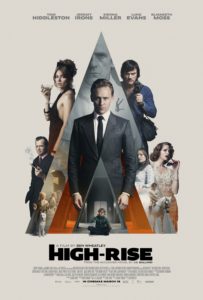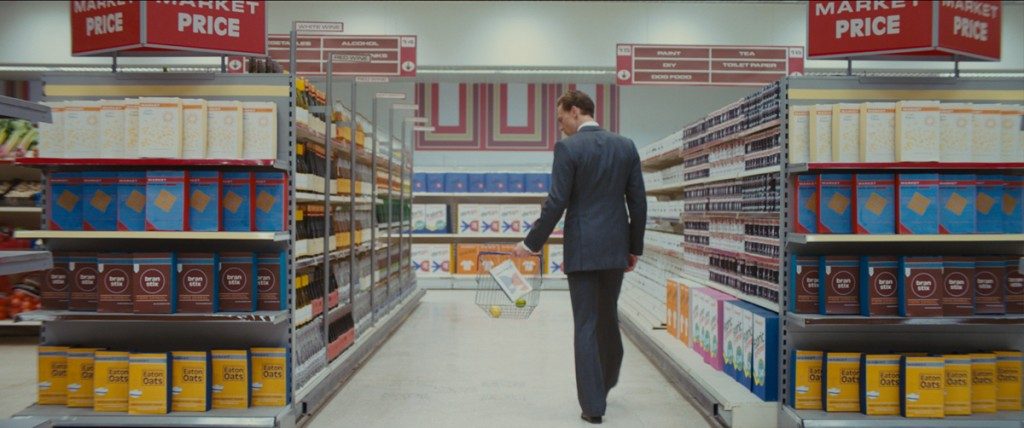
High Rise
Directer: Ben Wheatley
Writers: Amy Jump (based on the novel by J.G. Ballard)
Starring: Tom Hiddleston, Jeremy Irons, Sienna Miller, Luke Evans, Elisabeth Moss, James Purefoy
A review by Michael Walls-Kelly
 High-Rise is a pitch black comedy, warping together a ‘70s British style with brutalist architecture, social satire, and Terry Gilliam-esque visuals. The end result is a slightly uneven, yet fully-imagined film that will either stick with you or make you turn it off before it’s done.
High-Rise is a pitch black comedy, warping together a ‘70s British style with brutalist architecture, social satire, and Terry Gilliam-esque visuals. The end result is a slightly uneven, yet fully-imagined film that will either stick with you or make you turn it off before it’s done.
This adaptation of J.G. Ballard’s 1975 novel of the same name seems to take its mission statement from the book’s infamous first line:
“Later, as he sat on his balcony eating the dog, Dr. Robert Laing reflected on the unusual events that had taken place within this huge apartment building during the previous three months.”
The line, like the movie, turns the absurd and grotesque into the mundane.
High-Rise is the story of the hierarchy and tension in an apartment complex. Dr. Robert Laing (Tom Hiddleston) is a new tenant; a disaffected, middle-class doctor who wanders through the inner-workings of the tower block like a ghost. The lower-class residents include a single mother (Sienna Miller), an unsuccessful documentarian (Luke Evans) and his wife (Elisabeth Moss). The higher-class residents are led by the architect of the high-rise, Anthony Royal (Jeremy Irons), a seemingly sympathetic artist and idealist.
Clashes between the two parts of this society slowly start to escalate. There are arguments in the on-site supermarket and pool, clashes over the power surges in the building. Eventually it spirals out of control and the entire building falls into chaos.

Ben Wheatley gives the film a ‘70s aesthetic while keeping his own off-kilter style. Like his previous films (Kill List, A Field in England) show, Wheatley isn’t afraid of getting weird. That makes him the perfect director for this adaptation. It’s surprisingly faithful to the novel and fairly mainstream as far as Wheatley is concerned. Well, as mainstream as a movie which includes supermarket brawls over a can of grey paint, visions of dancing stewardesses, and threats of lobotomy can be.
The only real issue with the movie is the pacing, which seems to stop and start in fits. The situation seems to be calling for a slow buildup of tension and release but it gets subverted by oddly placed montages or cuts. The film ended up feeling its length because there were a few moments that pulled me out of the flow.
The biggest benefit the film has is the stellar cast. Hiddleston is perfect, playing it aloof and confused, the embodiment of the oblivious middle-class. He’s matched by Luke Evans, an actor I hadn’t given much credit to before, but who totally embodies the appropriately-named Richard Wilder. The rest of the cast does well, especially Sienna Miller and James Purefoy. Miller is kind of lost in the shuffle early on but comes into her own in the latter half of the film.
The social commentary in High-Rise is blunt and occasionally obvious — the rich treat the poor poorly, news at eleven — but it’s almost always entertaining. The high-rise itself is the concrete, curled fingers of a fist with the top floors literally blocking out the sun for those below them. One of the funniest scenes in the movie is when you realize these characters can extract themselves from the chaos whenever they want. But, of course, they don’t. This is their life. The high-rise is England and England is the World. Some people want to create a utopia, some people want to maintain order, and some people just want to make sure they have the perfect shade of grey for their walls.
The Verdict:
See it. I make no guarantee that anyone who watches this movie will enjoy it. I’m sure a lot of people will be turned off by it. But High-Rise is such a singular movie that it’s worth watching all the same. The comparison to Snowpiercer isn’t really accurate. Both movies have social commentary and are uniquely funny and weird, but they’re so distinct from each other. High-Rise is worth checking out purely on the strength of Ben Wheatley’s visuals, the spectacular throwback production design and the cast’s on-point and off-the-wall performances.


![[REVIEW] X-MEN ANNUAL #1](https://geekd-out.com/wp-content/uploads/2022/12/xmen-annual-1-feat-150x150.jpg)
